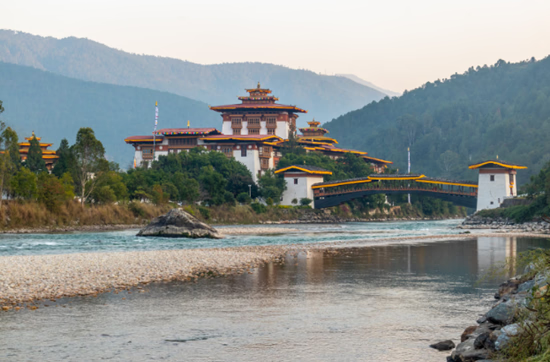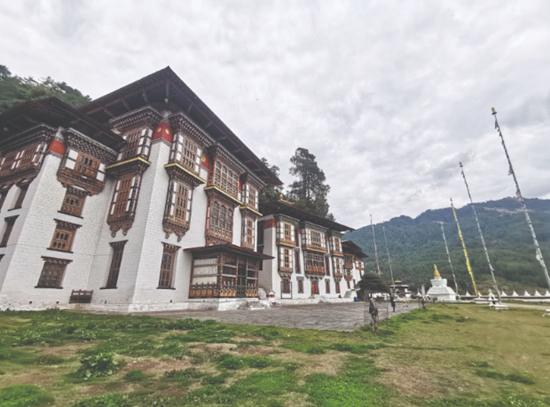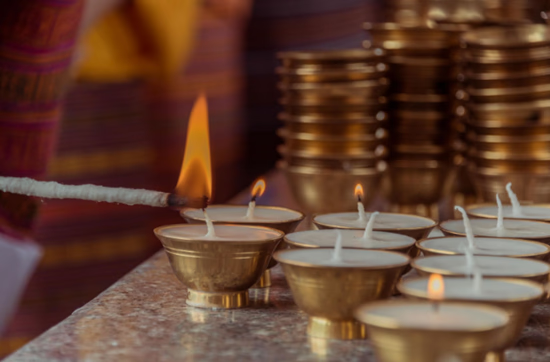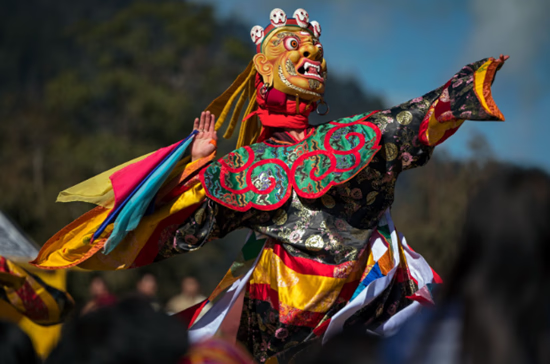Both Mongolia and Bhutan are places where Buddhism forms the heartbeat of daily life and shapes the soul of the nation. Despite the distance between them, these two lands are bound by deep spiritual roots, breathtaking natural beauty, and a profound reverence for sacred traditions. For Mongolian travellers, a pilgrimage to Bhutan offers the chance to immerse yourself in a unique tapestry of Buddhist practice, cultural nuance, and untouched Himalayan nature.
Imagine leaving behind the vast Mongolian grasslands and arriving in a kingdom where mountains are honoured as deities, prayer flags flutter on crisp mountain air, and monasteries cling to mist-shrouded cliffs. In Bhutan, Vajrayana Buddhism is not just practiced—it is lived, with centuries-old chants echoing through high valleys and compassion at the core of every encounter. For Mongolian pilgrims and seekers, travelling to Bhutan is more than a change of scenery—it is a journey into the heart of a spiritual sibling, filled with new inspiration, perspective, and a deep renewal of faith amidst some of the world’s most awe-inspiring landscapes.

1. The Ideal Itinerary: Mongolia → Kathmandu → Bhutan
Step 1: Travel from Mongolia to Kathmandu
Why Kathmandu?
Kathmandu, Nepal, is not only a convenient aviation hub, but also a major Buddhist pilgrimage destination, home to Boudhanath Stupa, Swayambhunath, and Pashupatinath Temple. Kathmandu and Bhutan together offer a truly unique pilgrimage across the living heartlands of Himalayan Buddhism. Kathmandu, with its ancient stupas, monasteries, and sacred sites like Boudhanath and Swayambhunath, is a vibrant crossroads where Tibetan, Nepali, and international pilgrims converge in daily rituals and timeless traditions. Here, you can meditate among monks, light butter lamps, and walk in the footsteps of sages and saints.
Flights from Mongolia to Kathmandu:
Fly from Ulaanbaatar to Kathmandu via Beijing, Delhi, or Bangkok. There are no direct flights, but connections are straightforward with a single stopover.
Step 2: Kathmandu – Explore the Heart of Himalayan Buddhism
Spend 1-3 days visiting major pilgrimage sites in Kathmandu Valley.
Join prayers at Boudhanath, spin the prayer wheels, and consult with Tibetan lamas for special blessings.
Step 3: Fly from Kathmandu to Paro, Bhutan
Bhutan’s national carrier, Drukair (Royal Bhutan Airlines), offers regular direct flights from Kathmandu to Paro International Airport, Bhutan.
Check out the latest Drukair flight schedule.
The total flight duration from Kathmandu, Nepal to Bhutan is about 1 hour. To have a view of the gorgeous Himalayan range, you can try to request for a left seat of the aircraft.
Step 4: Bhutan Pilgrimage
2. Top Attractions in Kathmandu, Nepal
-
1. Circumambulate and Meditate at Boudhanath Stupa
One of the holiest Buddhist sites outside Tibet, Boudhanath’s majestic white dome and all-seeing eyes draw pilgrims from across the world. Join the daily kora (circumambulation), spin prayer wheels, light butter lamps, and participate in chanting or silent meditation with monks.
-
2. Visit Swayambhunath (Monkey Temple)
Perched atop a hill overlooking Kathmandu, this ancient stupa is shrouded in legend and offers sweeping valley views. Climb the 365 steps, spin the prayer wheels, and observe both Buddhist and Hindu rituals taking place side by side.
-
3. Experience Monastic Life at Kopan Monastery
Kopan is renowned for its welcoming approach to international pilgrims. Join a meditation retreat, attend Dharma talks, or simply soak in the tranquil monastic atmosphere while interacting with monks and nuns.
-
4. Explore Patan’s Buddhist Monasteries (Vihars)
Patan, just south of Kathmandu, is home to centuries-old Buddhist monasteries and courtyards. Don’t miss Hiranya Varna Mahavihar (“Golden Temple”) and Mahabouddha Temple, known for its thousand Buddha images.
-
5. Discover Asura and Yangleshö Caves in Pharping
Just outside Kathmandu, these sacred meditation caves are where Guru Rinpoche (Padmasambhava) is said to have attained enlightenment. Meditate in the peaceful surroundings or join prayer sessions at nearby monasteries.
-
6. Attend a Buddhist Puja or Teaching
Many monasteries in Kathmandu, especially around Boudhanath and Kopan, welcome pilgrims to join daily pujas (prayer ceremonies), chanting sessions, or special teachings when available.
-
7. Light Butter Lamps and Make Offerings
Participate in the deeply symbolic act of lighting butter lamps at Boudhanath or Swayambhunath, dedicating merit to loved ones and all beings.
-
8. Visit the International Buddhist Meditation Centre (IBMC)
Located in the quiet suburbs, IBMC offers meditation classes, courses, and a peaceful garden ideal for personal reflection.
-
9. Browse for Buddhist Texts and Ritual Items
Around Boudhanath, you’ll find bookstores and shops selling Tibetan Buddhist texts, thangkas, prayer beads, singing bowls, and other sacred items.
If you have more nights to spare, you can also take a bus ride to Pokhara that is approximately 7 hours away. Pokhara is also the gateway for the Annapurna Circuit. It’s less crowded than Kathmandu and offers a stunning view of the Fewa Lake, Nepal’s most beautiful lake.
Bonus Tip: Consider visiting Nepal before travelling on to Bhutan. Nepal is well-established as a major tourist destination, having welcomed international travellers long before Bhutan opened its doors. Exploring Nepal first allows you to experience its vibrant culture and iconic sites before continuing your journey into the serene landscapes of Bhutan.
3. Why Pilgrimage to Bhutan?
For Mongolians, a visit to Bhutan is an immersion in living Vajrayana tradition. The energy of ancient meditation caves, sacred relics, and blessing ceremonies in Bhutan offer a unique spiritual experience, often described as “stepping into a living mandala”.

Key Pilgrimage Sites in Bhutan
-
Paro Taktsang (Tiger’s Nest Monastery)
No spiritual journey to Bhutan is complete without a pilgrimage to Paro Taktsang, the legendary Tiger’s Nest Monastery. Clinging dramatically to a sheer cliff 900 metres above the Paro Valley, this sacred site is believed to be where Guru Rinpoche—revered as the Second Buddha—meditated after arriving on the back of a flying tigress. The monastery’s location alone inspires awe, shrouded in mist and surrounded by ancient pine forests. The challenging hike to reach Taktsang is itself a form of devotion, rewarding pilgrims with not only panoramic Himalayan views but also the profound tranquillity of the monastery’s prayer halls, fluttering prayer flags, and centuries-old murals. To stand in Tiger’s Nest is to touch the very soul of Bhutanese Buddhism.

-
Kyichu Lhakhang
Nestled quietly in the Paro Valley, Kyichu Lhakhang is one of the oldest and most venerated temples in Bhutan. Legend holds that it was built in the 7th century by the Tibetan King Songtsen Gampo as part of a grand effort to subdue a demoness whose body was said to lie across the Himalayas. The temple is intimately connected to Guru Rinpoche, who is said to have visited and sanctified the site. Pilgrims are drawn to Kyichu Lhakhang’s serene atmosphere, the gentle spinning of prayer wheels, and the orange trees in the courtyard that are said to bear fruit throughout the year—a sign of the temple’s enduring spiritual power. For Mongolian Buddhists, the temple’s ancient relics and quiet sanctity offer a tangible link to the earliest days of Vajrayana practice.
-
Punakha Dzong
Regarded as the “Palace of Great Happiness,” Punakha Dzong is both a spiritual stronghold and a masterpiece of Bhutanese architecture. Strategically situated at the confluence of the Pho Chhu and Mo Chhu rivers, the dzong has served as the seat of Bhutan’s monastic body and the site of royal coronations and important spiritual rituals. The fortress-like structure is adorned with intricate woodwork, vibrant murals, and storied courtyards where monks conduct sacred dances and prayers. Pilgrims come not only to admire the dzong’s grandeur but to receive blessings from the central assembly hall and to witness the annual Punakha Drubchen and Tshechu festivals—occasions of deep spiritual merit.

-
Bumthang Valley
Often referred to as the spiritual heartland of Bhutan, Bumthang Valley is home to some of the country’s most sacred temples and revered pilgrimage sites. The valley’s gentle slopes are dotted with ancient monasteries such as Jambay Lhakhang—one of the 108 temples believed to have been built by King Songtsen Gampo in a single night—and Kurjey Lhakhang, where Guru Rinpoche left his body imprint on a rock. Bumthang is a place where legends come alive: from hidden treasures (termas) said to be concealed in the landscape to tales of flying lamas and miraculous healings. For pilgrims, a journey through Bumthang is an immersion into the living history and mystical energy of Bhutanese Buddhism, with opportunities for meditation, reflection, and deep connection to the sacred.

-
Gangtey Goemba
Gangtey Monastery, also known as Gangtey Goemba, is a centuries-old Buddhist monastery perched on a hilltop in the stunning Phobjikha Valley. Renowned for its serene atmosphere and breathtaking views, it is an important centre for the Nyingma school of Tibetan Buddhism and plays a central role in local festivals, especially the annual Black-Necked Crane Festival. The monastery’s unique location and spiritual significance make it a cherished pilgrimage site in Bhutan.

4. Practical Tips: Pilgrimage Travel from Mongolia to Bhutan
-
Visa & Permits:
Getting a visa for Bhutan is a simple process for citizens of Mongolia, if you book your trip with Druk Asia, we will take care of all necessary paperwork including your visa application to Bhutan. You just need to send us an electronic version with a full-color image of your passport that has at least 6 months validity.
-
Tour Packages:
Opt for a Buddhist-focused or pilgrimage-themed itinerary. Druk Asia offers customisable packages including bundle tours for Nepal and Bhutan.
-
Travel Seasons:
Bhutan is a year-round travel destination, welcoming visitors in every season. Spring (March–May) and autumn (September–November) are especially popular for their vibrant festivals, clear weather, and spiritual celebrations.
-
Cultural Etiquette:
Dress modestly, respect local customs, and always ask before photographing monks or rituals.
-
Language:
English is widely used in Bhutan’s tourism sector.
-
Health & Altitude:
Both Kathmandu and Bhutan are at higher altitudes; acclimatise slowly, especially if trekking or meditating in remote sites.

For Mongolians, visiting Bhutan is more than a physical journey—it is a spiritual homecoming. Both countries cherish their Buddhist roots, yet each offers a distinct expression of devotion. Hiking up to Tiger’s Nest, the pilgrimage is an invitation to rediscover the unity of faith, culture, and awe-inspiring landscapes.
By combining Kathmandu and Bhutan, you unlock a seamless, inspiring Buddhist journey—across three lands, one faith, and countless blessings.
Get in touch with Druk Asia to customise your Bhutan tour.
5. How much does a Bhutan tour cost?
Bhutan Tour Package
If you wish to explore beyond Paro and Thimphu, you must book a tour package through a licensed operator. This usually includes:
Accommodation
All meals
Licensed guide and driver
Private transport within Bhutan
Entry fees to monuments and monasteries
Average package cost:
USD $300–$450 per person, per night
For 7 nights: Approximately USD $2,100–$3,150
A round trip from Kathmandu, Nepal to Bhutan is approximately USD 450 per pax.
However, airfare and taxes are subjected to change. Please check with our friendly travel consultants at Druk Asia for the latest information.
6. What are some popular Bhutan tour packages?
Below are some popular Druk Asia tour packages that you can choose from:-
Trekking tour
9 Day Druk Path trek
9 Day Dagala Thousand trek
11 Day Jomolhari Trek
Cultural tour
7 Day tour in Thimphu, Punakha and Paro
10 Day tour in Thimphu, Punakha, Bumthang, Gangtey and Paro
Meditation tour
7 Day Neykor tour
We are happy to customise your Bhutan itinerary to suit your personal preferences, ensuring your journey to Bhutan is truly unforgettable. Whether you’re interested in a Buddhist pilgrimage, a spiritual retreat, or a combined Nepal and Bhutan tour, simply let our Travel Specialist know your wishes—and we’ll create a unique experience just for you.
Druk Asia also offers special interests tours such as photography and sketching tours. Aside from that, we also organise pre-wedding photography trips.
7. What is the temperature and climate in Bhutan and Nepal
Due to its location, Bhutan’s weather and climate are heavily influenced by its altitudes and terrains. Western Bhutan has heavier monsoon rains while southern Bhutan has a hot and humid subtropical climate with a monsoon season that is consistent throughout the year. The southern region also receives a significant amount of rain in a year and heavy rainfall can sometimes cause landslides and render roads impassable. Central Bhutan, where the major towns and tourist attractions are located, has a more seasonal climate with warm summers before the monsoon. The winters are usually cool and dry with clear blue skies. In the far northern region, the weather has a harsher climate and is much colder during winter. Mountain peaks are perpetually covered in snow and lower-lying areas
| |
Celcius |
Jan |
Feb |
Mar |
Apr |
May |
Jun |
Jul |
Aug |
Sep |
Oct |
Nov |
Dec |
| Paro(West) |
Max |
9.4 |
13.4 |
14.5 |
17.6 |
23.5 |
25.4 |
26.8 |
25.3 |
23.4 |
18.7 |
13.9 |
11.2 |
| Min |
-5.8 |
1.5 |
0.6 |
4.6 |
10.6 |
13.1 |
14.9 |
14.7 |
11.7 |
7.4 |
1.4 |
-1.7 |
| Thimphu(West) |
Max |
12.3 |
14.4 |
16.4 |
20.0 |
22.5 |
24.4 |
18.9 |
25.0 |
23.1 |
29.1 |
17.9 |
14.5 |
| Min |
2.6 |
0.6 |
3.9 |
7.1 |
13.1 |
15.2 |
13.4 |
15.8 |
15.0 |
10.4 |
0.5 |
-1.1 |
| Punakha(West) |
Max |
16.1 |
19.6 |
21.2 |
24.4 |
27.2 |
31.2 |
32.0 |
31.4 |
29.9 |
27.8 |
22.3 |
15.0 |
| Min |
4.2 |
5.3 |
9.2 |
11.9 |
14.8 |
19.5 |
21.6 |
19.8 |
20.0 |
18.9 |
13.0 |
7.9 |
| Wangdue(West) |
Max |
17.0 |
19.0 |
22.8 |
26.2 |
29.9 |
29.2 |
18.4 |
29.1 |
27.5 |
26.1 |
22.6 |
19.1 |
| Min |
4.3 |
7.8 |
10.4 |
12.9 |
17.7 |
20.1 |
16.2 |
20.0 |
19.1 |
14.7 |
9.6 |
6.3 |
|
Trongsa(Central) |
Max |
13.0 |
13.9 |
16.7 |
20.1 |
21.0 |
22.2 |
25.3 |
23.8 |
22.6 |
21.8 |
19.8 |
18.2 |
| Min |
-0.2 |
0.4 |
4.4 |
6.6 |
11.6 |
13.6 |
15.3 |
15.0 |
14.2 |
11.7 |
6.4 |
2.5 |
| Bumthang(Central) |
Max |
10.8 |
10.0 |
16.2 |
18.7 |
21.3 |
22.5 |
14.1 |
23.0 |
21.6 |
19.5 |
16.1 |
12.3 |
| Min |
-5.1 |
-1.4 |
3.5 |
3.9 |
9.5 |
13.5 |
10.9 |
13.7 |
12.1 |
5.9 |
-0.5 |
-2.3 |
| Mongar(East) |
Max |
15.5 |
15.9 |
20.0 |
22.8 |
25.1 |
26.1 |
27.1 |
25.4 |
24.7 |
22.7 |
19.9 |
17.7 |
| Min |
8.2 |
8.3 |
11.6 |
14.0 |
17.4 |
19.5 |
19.8 |
19.6 |
19.4 |
15.8 |
11.2 |
9.5 |
| Trashigang(east) |
Max |
20.4 |
21.7 |
24.8 |
28.3 |
30 |
30.7 |
31.5 |
30.2 |
30.0 |
29.1 |
26.1 |
23.0 |
| Min |
10.5 |
11.5 |
4.4 |
17.0 |
22.6 |
22.6 |
23.1 |
22.7 |
21.9 |
17.7 |
13.6 |
11.6 |
Climate in Nepal is pretty similar to Bhutan where it’s largely influenced by elevation. In Kathmandu Valley, average temperatures can range from 50° F (10° C) in January to 78° F (26° C) in July, and the lowest and highest temperatures recorded have been 27° and 99° F (-3° and 37° C)
8. Cuisine in Nepal and Bhutan: A Guide for Mongolian Travellers
8.1 Nepalese Cuisine
Nepal’s food is diverse, flavourful, and influenced by Indian, Tibetan, and local traditions.
Familiar Elements:
Hearty soups and stews (similar to Mongolian tsuivan or noodle soups).
Dumplings, especially momos—a Tibetan-style steamed or fried dumpling filled with meat or vegetables, very popular and widely available.
Noodles and fried rice dishes.
Typical Dishes:
Dal Bhat: A staple meal of rice, lentil soup, and various vegetable or meat curries.
Thukpa: A warming noodle soup with vegetables and/or meat, similar to Mongolian noodle soups.
Gundruk: Fermented leafy greens, offering a distinct flavour.
Sel Roti: A rice-based, doughnut-like snack.
For Buddhist Pilgrims:
Vegetarian options are widely available, especially in Buddhist areas.
Many monasteries and restaurants cater for vegetarian diets, and lentil dishes are common.
8.2 Bhutanese Cuisine
Bhutanese food is hearty, warming, and often features bold chilli flavours.
Familiar Elements:
Lots of meat-based stews (usually pork, beef, or chicken) served with rice.
Dumplings known as momos are popular in Bhutan too.
Dairy, especially cheese, features heavily in the cuisine—reminiscent of Mongolian use of dairy, though the taste and style differ.
Typical Dishes:
Ema Datshi: The national dish, a spicy stew of chillies and cheese—distinctly Bhutanese and much spicier than Mongolian food!
Phaksha Paa: Pork cooked with chillies and radish.
Jasha Maru: Spicy chicken stew.
Red Rice: A Bhutanese staple, nutty and filling.
For Buddhist Pilgrims:
Vegetarian meals are easy to request and commonly prepared, especially for visitors or during religious festivals.
If you are sensitive to spicy food, let your hosts or guide know—most restaurants can adjust the spice level.
9. Popular & Interesting Bhutanese Festivals
Bhutan’s vibrant festivals—known as tshechus—are among the most remarkable cultural and spiritual spectacles in the entire Himalayan region. Deeply rooted in Vajrayana Buddhist tradition, these festivals bring together communities to honour sacred stories, receive blessings, and celebrate the living faith that shapes Bhutanese life.
For Mongolian travellers, who share many of these Buddhist customs and beliefs, attending a tshechu is both a familiar and awe-inspiring experience. The rhythmic beats of drums, swirling masked dancers, and the collective prayers of monks and devotees create an atmosphere charged with spiritual energy and joy. These festivals are not only a chance to witness unique rituals and colourful performances but also an opportunity to participate in timeless ceremonies that transcend borders and generations.
Here are some of the most popular and interesting Bhutanese festivals that are both fascinating and profoundly inspiring:

Check out the latest Bhutan festival calendar.
FAQs for Mongolians Travelling to Bhutan
1. Do Mongolian citizens need a visa to visit Bhutan?
Yes. Mongolian citizens require a Bhutanese visa, which must be arranged before arrival. Druk Asia can apply for a visa on your behalf if you are booking your Bhutan tour package through us.
2. How much is the Bhutan visa application fee?
Bhutan’s visa application fee is USD $40 per person. This fee is a one-time charge and is usually included in your tour package
3. Can I travel to Bhutan independently as a Mongolian?
Since September 2022, independent travel is permitted for international tourists within the cities of Paro and Thimphu only. For journeys beyond these areas (e.g. Punakha, Bumthang, Haa, Phobjikha, etc.), travel must be arranged through a licensed Bhutanese tour operator.
Note: Even within Paro and Thimphu, booking through a tour operator is highly recommended for ease of logistics, local insights, and access to guides.
4. How do I apply for a Bhutan visa?
If travelling only within Paro and Thimphu: Apply directly through the official Bhutan travel portal.
If travelling beyond Paro/Thimphu: Book your trip through a licensed tour operator, who will arrange your visa as part of your package.
5. Are there direct flights from Mongolia to Bhutan?
No. You must transit through a major Asian hub such as Singapore, Bangkok, or Kathmandu to connect to Paro International Airport.
6. Can I combine my Bhutan trip with Nepal or India?
Yes. Many Mongolian travellers visit Kathmandu (Nepal) or Delhi (India) before flying to Bhutan. These hubs are spiritual centres in their own right and offer direct flights to Bhutan.
7. What documents do I need to show at entry?
Passport with minimum 6 months validity
Approved Bhutan visa (printed or digital copy)
Proof of onward or return ticket
8. What is the Sustainable Development Fee (SDF)?
All tourists must pay a daily Sustainable Development Fee (currently USD $100 per night). This applies whether you travel independently or through a tour operator. The SDF is used to fund various developmental projects in Bhutan, including environmental conservation, infrastructure development, cultural preservation, and social services.
9. Are there Mongolian Buddhist communities or monasteries in Bhutan?
There are no established Mongolian monastic communities in Bhutan. However, Bhutanese monastic institutions warmly welcome Buddhist pilgrims from Mongolia, and you may request meetings or joint prayers with monks and lamas through your tour organiser.
10. Are there restrictions on religious ceremonies for foreign pilgrims?
Most monasteries are happy to offer blessings, prayer ceremonies, or even short meditation sessions for visitors if arranged in advance. However, some deeper rituals or initiations may be reserved for Bhutanese practitioners. Discuss your wishes with your tour operator before your visit.
11. Can I purchase religious artefacts or souvenirs in Bhutan?
Yes. You can find prayer wheels, thangka paintings, statues, incense, and other Buddhist items in shops and markets, especially in Paro and Thimphu.
12. What currency is used in Bhutan? Can I use foreign cash or cards?
The official currency is the Ngultrum (BTN), pegged to the Indian Rupee. It’s advisable to carry some cash for monasteries, small purchases, and tips. US dollars and euros are commonly exchanged.
13. Is it possible to do meditation retreats or study Buddhism in Bhutan?
Yes, we can arrange for meditation retreats and teachings in advance. Let us know your interests before your trip so proper arrangements can be made.
14. Is the weather in Bhutan similar to Mongolia?
No, Bhutan’s weather is typically milder and more humid, especially in the valleys. Summers are lush and green, while winters are cool but rarely as extreme as the Mongolian winter. Always check the seasonal weather for your travel dates and pack accordingly.
15. Is vegetarian food easily available in Bhutan?
Yes, Bhutan offers a range of vegetarian meals, especially at tourist hotels and during religious festivals. Let us know your dietary preferences in advance.
